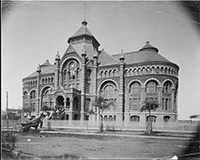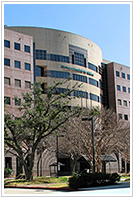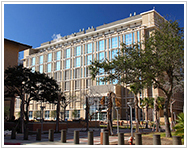The History of the UTMB John Sealy School of Medicine
Founded as the state's first medical school in 1891, the University of Texas Medical Branch at Galveston (UTMB) has served the health care needs of Texans for more than a century with outstanding programs in health science education, patient care, and research.
 The University of Texas Medical Branch's Ashbel Smith building, which appears to the left and is affectionately known as Old Red,
has played a vital role in the history of UTMB. Completed in 1890, and
built in the Romanesque Revival style, its colorful nickname comes from
the materials it is made from - red pressed brick, red Texas granite,
and sandstone.
The University of Texas Medical Branch's Ashbel Smith building, which appears to the left and is affectionately known as Old Red,
has played a vital role in the history of UTMB. Completed in 1890, and
built in the Romanesque Revival style, its colorful nickname comes from
the materials it is made from - red pressed brick, red Texas granite,
and sandstone.
As the oldest medical school building in
Texas, Old Red is listed on the National Register of Historic Places and
marked with a Texas Historical Commission placard. Old Red has truly
earned its landmark status by surviving the Galveston hurricane of 1900,
one of the worst natural disasters in U.S. history. Although the storm
destroyed much of Old Red's original roof, the main structure remained
standing. Today, Old Red continues to serve thousands of UTMB students,
faculty, staff, and visitors and currently houses administrative
offices, the School of Medicine's Alumni Association office, a teaching
amphitheater, the Institute for the Medical Humanities, and the anatomy
laboratory used in the training of future physicians.
 Over the past 130 years, UTMB has conferred more than 25,000 degrees
to students in medicine, nursing, biomedical sciences, and the allied
health sciences. From its small beginnings as one hospital and one
school with 23 students, UTMB today consists of six hospitals, four
schools with 2,500 students and residents, an extensive network of
campus- and community-based clinics, a Level I trauma center, two
institutes, an affiliated Shriners Burns Hospital, seen
to the left, and state-of-the-art research facilities. UTMB
has been ranked the nation's top producer of medical degrees for
Latinos and second-highest producer of medical degrees for African
Americans from 2000 to 2021, per reporting by The Integrated
Postsecondary Education Data System (IPEDS).
Over the past 130 years, UTMB has conferred more than 25,000 degrees
to students in medicine, nursing, biomedical sciences, and the allied
health sciences. From its small beginnings as one hospital and one
school with 23 students, UTMB today consists of six hospitals, four
schools with 2,500 students and residents, an extensive network of
campus- and community-based clinics, a Level I trauma center, two
institutes, an affiliated Shriners Burns Hospital, seen
to the left, and state-of-the-art research facilities. UTMB
has been ranked the nation's top producer of medical degrees for
Latinos and second-highest producer of medical degrees for African
Americans from 2000 to 2021, per reporting by The Integrated
Postsecondary Education Data System (IPEDS).
 In 2003 UTMB received funding to construct a $150 million Galveston National Biocontainment Laboratory
on its campus, one of the few non-military facilities of this level. It
houses several Biosafety Level 4 research laboratories, where studies
on highly infectious materials can be carried out safely.
In 2003 UTMB received funding to construct a $150 million Galveston National Biocontainment Laboratory
on its campus, one of the few non-military facilities of this level. It
houses several Biosafety Level 4 research laboratories, where studies
on highly infectious materials can be carried out safely.
Areas of clinical excellence provided for all Texans include geriatrics,
cardiac services, diabetes care, kidney disease, telemedicine, and
behavioral health. UTMB's nationally recognized and growing research
programs focus on biodefense and infectious diseases, vaccine
development, aging and longevity, neuroscience, molecular medicine,
environmental health, asthma, gastrointestinal health, cancer, and
diabetes.